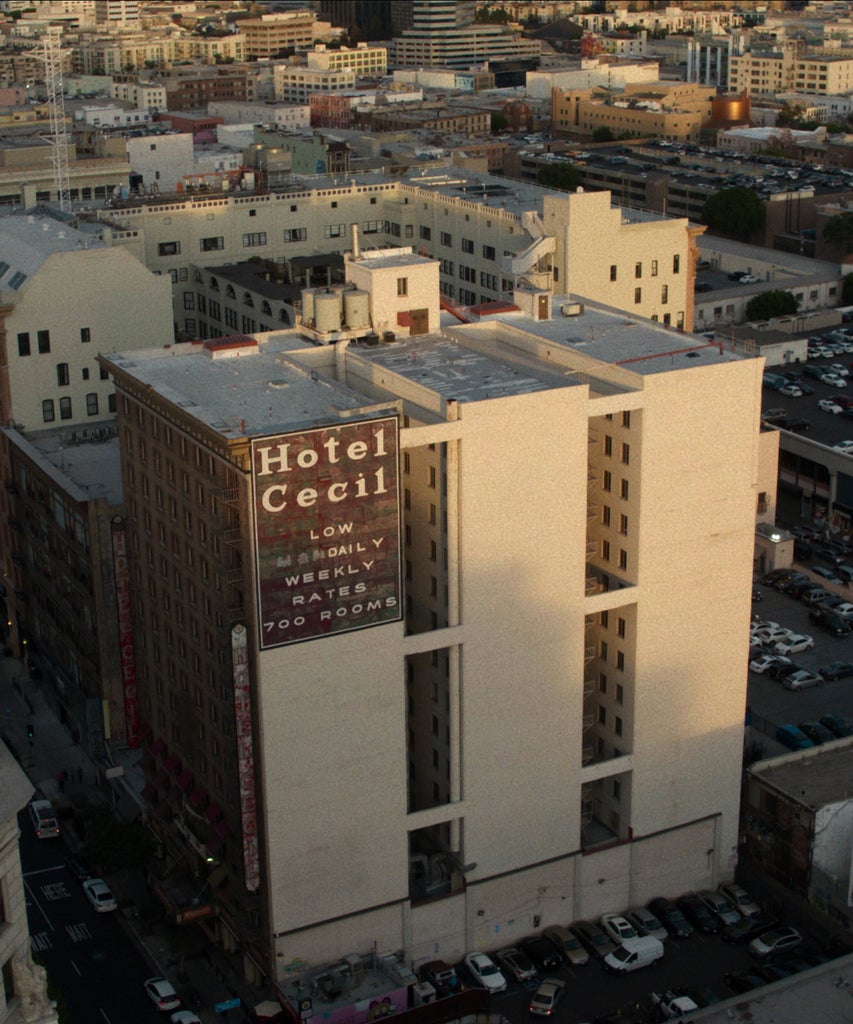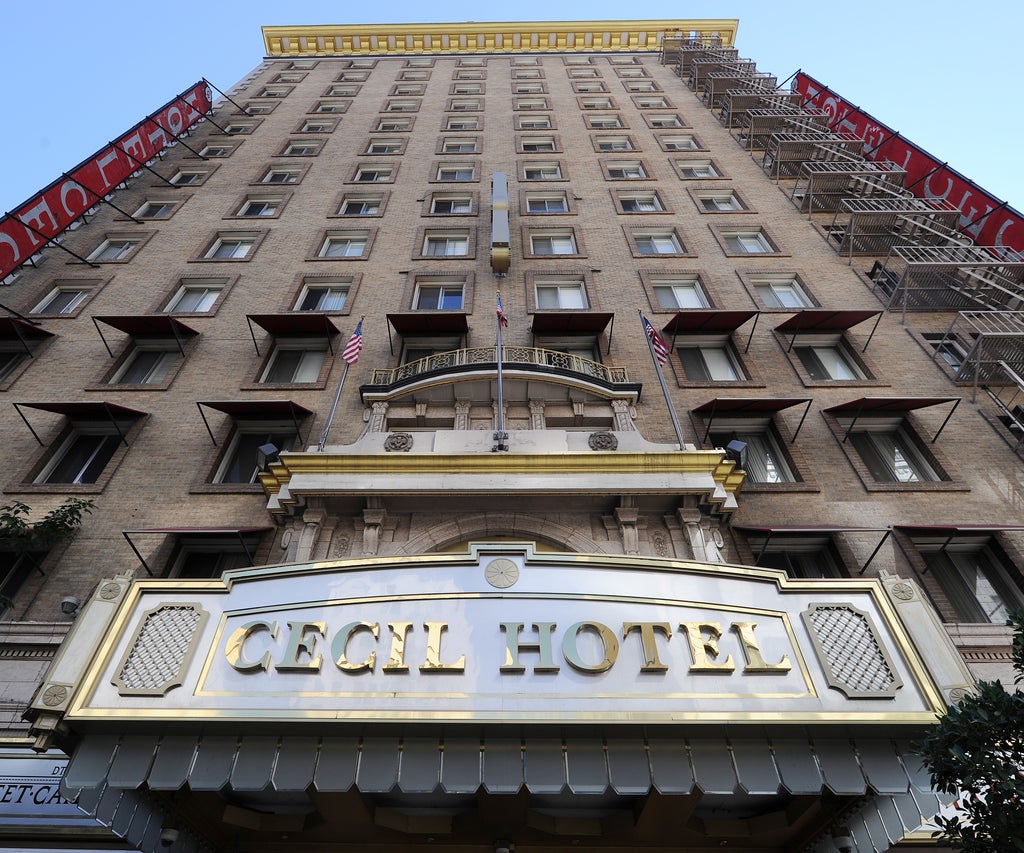
The new Netflix anthology series, Crime Scene: The Vanishing at the Cecil Hotel, takes a closer look at the 2013 disappearance of Canadian college student Elisa Lam. Unfortunately, Lam’s bizarre vanishing is not unique to Los Angeles’s most notorious hotel. The nightmarish history of the Cecil Hotel, which first opened in 1927, earned it the nickname “the most haunted hotel in L.A.”
This is all to say that the eerie building, which once housed not one, but two serial killers, was infamous long before Netflix came calling. It’s believed that at least 16 different murders, suicides and other ghastly — and, possibly, ghostly — incidents took place at the downtown L.A. space. It’s such a frightening locale that six years ago, American Horror Story used it as inspiration for its aptly titled fifth season, Hotel, starring Lady Gaga.
Despite recent renovations and attempts at re-branding the hotel as Stay On Main, the unexplained spookiness hasn’t gone away — and neither have the conspiracy theories surrounding the goings on there. While the hotel’s nefarious activity may never be explained, its history often repeated itself in the most tragic of ways.
The Location Of The Cecil Hotel & Skid Row
We cannot, however, talk about the Cecil Hotel without addressing its location. In 1924, hotelier William Banks Hanner had the idea to open a glamorous destination hotel in the city of stars. He chose an extravagant million dollar building in Los Angeles — which would cost $13 million today — that had a marble lobby and stained glass windows. He hoped 604 Main Street would become a destination for business travellers and tourists coming to see the Hollywood sights. When the 19-floor hotel opened in 1927, it seemed like a sure thing. Unfortunately, he couldn’t foresee that the Great Depression which would turn his Beaux Arts stunner into a violent haven for criminals and addicts.
Many blame this on the Cecil’s proximity to Skid Row, an area of downtown L.A. that, shortly after the depression, became overwhelmed by desperate poverty and homelessness. With every economic downturn the neighbourhood saw an influx in its population. “In the late ’60s, the amount of low-cost rental housing in the area was halved right before the oil crisis in 1971,” The Daily Beast wrote in 2015. “In the late ’80s, the explosion of crack cocaine hit just in time for the recession of the early ’90s and the privatisation of state mental hospitals, which was overseen by then-Gov. Ronald Reagan.”
As Crime Scene shows, though, those that live in Skid Row have been the scapegoats for everything bad that happens in the downtown area without much evidence. In fact, community advocates make the case that the real problem of Skid Row is that those living there, many of whom struggle with drug and alcohol addiction or mental illness, have never been given the help they need. Those who call Skid Row home are themselves victims of gentrification, siloed off so they don’t ruin the image of a clean downtown area for tourists. Unfortunately, the Cecil has never quite fit that perfect image either.
Early Murders & Deaths At The Cecil Hotel
The first known incident at the Cecil Hotel was in 1931, four years after it opened. Forty-six-year-old W. K. Norton was the first reported death by suicide at the hotel. The Manhattan Beach, CA resident, who checked in under the pseudonym “James Willys,” ingested pills.
Over that early decade, he was one of six people who reportedly died by suicide at The Cecil. Unfortunately, this sad pattern would continue leading those who lived in the hotel long term to refer to it as “The Suicide.” In the Netflix series, former manager Amy Price explains that the hotel “consistently had people pass away. I believe in the 10 years I worked there, there were about 80 deaths.” A terrifying number that led her to ask a fellow employee, “Is there a room here that somebody hasn’t died in?”
“I never got used to that,” she remarked.

The most horrifying incident at the hotel might be the case of Dorothy Jean Purcell. In 1944, she gave birth in the bathroom of a room she was sharing with her 38-year-old boyfriend, Ben Levine. The 19-year-old did not know she was pregnant and mistakenly thought that the baby boy had died in childbirth. She threw the newborn, who was still alive, out the window. Purcell was later found not guilty of murder by reason of insanity.
The Cecil’s Claims To Infamy, From The Black Dahlia To Richard Ramirez
The most notorious murder at the Cecil, which is also the first known murder tied to the hotel, was that of Elizabeth Short, the aspiring actress who became posthumously known as “The Black Dahlia.” In 1947, Short was found in a park near the hotel, where she was allegedly seen in the days before her death. (Though some deny Short was ever at the hotel.)
Her murder was highly publicised due to its gruesome nature; her body had been severed in two with her mouth having been slit from ear to ear. Despite over 500 confessions to police, some from people who were not alive when the murder happened, her case has yet to be solved. L.A. crime historian Kim Cooper told Vice in 2015 that Lam’s tragic’s case drew comparisons to Short’s due to the public’s obsessive interest in the case.
However, Short isn’t the only unsolved murder tied to the Cecil. In 1964, “Pigeon” Goldie Osgood, a retired telemarketer known for feeding the pigeons in nearby Pershing Square, was found raped, strangled, and stabbed to death in her room. Despite the arrest of a passerby wearing bloody clothes, they let him go citing lack of evidence.
However, the most infamous death may be that of Pauline Otton, who, in 1962, leapt from her ninth floor window after fighting with her estranged husband. She landed on an elderly passerby, George Giannini, killing him and herself instantly.
Sadly, the horrors at the hotel didn’t end there, they just got weirder. In 1985, serial killer Robert “The Night Stalker” Ramirez, the focus of another recent Netflix docuseries, reportedly lived on the top floor of the Cecil during his murder spree. After his killings, he would discard his bloody clothes in the Cecil’s dumpster and walk into the hotel’s lobby in his underwear, or, quite possibly, completely naked, “none of which would have raised an eyebrow,” according to journalist Josh Dean, being that the hotel during that time was such a mess.
It’s also been reported that Austrian serial killer Jack Unterweger, who killed his female victims with their own bras, also spent time there in the early ’90s. His actions were said to be an homage to Ramirez. They weren’t the only murderers who hid out there though. A man accused of killing his girlfriend in Huntington Beach was arrested at the hotel in 1988. Seven years later, murder suspect Eric Reed was found holed up in the budget hotel after breaking out of a jail located 45 minutes away.
Cecil Hotel In Pop Culture — & That American Horror Story Season

Hollywood has spent decades bringing the horrors of the Cecil to the big and small screens. The Cecil inspired the deadly hotel that plays an important role in the Coen Brothers’s 1991 movie Barton Fink. It was the subject of a special episode of the paranormal reality show Ghost Adventures which was focused on Lam’s disappearance. The The NoSleep Podcast also dedicated a season 3 episode to a short story loosely based on Lam’s death.
Look close and you’ll see that the Cecil makes a cameo in U2’s video for “Where The Streets Have No Name,” which they filmed, in 1987, on the roof of the one-story building next door. It also pops up in the background of the Blink-182 video for “The Rock Show.”
While it’s unclear whether Elizabeth Short was ever at The Cecil, the story of the Black Dahlia has become a Hollywood staple. The first film adaptation of the murder was the 1975 TV movie Who Is the Black Dahlia? starring Lucie Arnaz. More recently, the murder was the subject of the Chris Pine-starring TV series I Am The Night. (She also shows up in the first season of AHS.)
The most notable bit of pop culture inspired by the Cecil is American Horror Story: Hotel. In season 5, the Hotel Cortez acts as the real life haunted hotel’s stand-in. The fictional hotel is being tormented by the trapped souls of those guests who have died, mostly by suicide, on its premises. At the Cortez, danger lurks at every turn, not unlike the Cecil. Except it’s in the form of literal vampires and ghosts who are stealing lives. Fortunately, Gaga’s vampiric Baroness, who owns the Cortez, is not based on anyone from the Cecil.
The Cecil Hotel Isn’t Open Anymore — For Now
Since the confounding case of Elisa Lam, there has been only one reported death: a 28-year-old man who, in 2015, was found outside of the hotel. He had been killed in an apparent fall. Two years later, the newly landmarked Cecil Hotel closed, but it likely won’t be for good. After a major renovation, the hotel is slated to reopen in late 2021.
Like what you see? How about some more R29 goodness, right here?
This Is What Happened To Cecil Hotel’s Elisa Lam